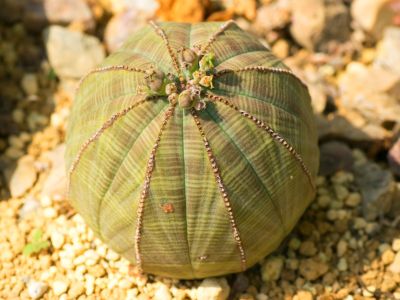Euphorbia Baseball Plant Info
There is a wide array of Euphorbia species. They range from cactus-like spiny plants to thickly padded succulents and even shrubby, woody plants with veined leaves. Baseball plant was first documented in 1897, but by 1915 Euphorbia obesa was considered endangered due to its popularity, which led collectors to pirate the natural population. This rapid decline in the population led to an embargo on plant material and an emphasis on seed collection. Today, it is a widely grown plant and easy to find in many garden centers. Euphorbia plants are classified by their white, milky latex sap and the cyanthium. This is the inflorescence composed of a single female flower surrounded by many male flowers. Euphorbia do not form proper flowers but develop inflorescences. They do not grow petals but instead have colored bracts which are modified leaves. In the baseball plant, the inflorescence or flower leaves behind a scar which is successively displayed on the aging body of the plant. The scarring is similar to the stitching on a baseball. Euphorbia baseball plant is also called sea urchin plant, partially due to the shape of the body, which resembles the creature, but also due to the native habit of growing on rocks and cliffs. Specific baseball plant info indicates it is a segmented, spherical plant with a rather bloated body that stores water. The round plant is grayish green and grows around 8 inches (20.5 cm.) tall.
How to Grow Baseball Euphorbia
Euphorbia obesa care is minimal, making it the perfect houseplant for someone who travels a lot. It simply requires heat, light, a well draining soil mix, a container, and minimal water. It makes a perfect container plant by itself or surrounded by other succulents. A good cactus mix or potting soil amended with grit make excellent mediums for growing a baseball plant. Add a little gravel to the soil and use an unglazed pot which will promote evaporation of any excess water. Once you have the plant in a location in your home, avoid moving it which stresses out the plant and can minimize its health. Overwatering is the most common cause of malaise in the baseball plant. It is used to only 12 inches (30.5 cm.) of rain per year, so a good deep watering once every few months in winter and once per month in the growing season is more than sufficient. Fertilizing is not necessary as part of good Euphorbia baseball care, but you can give the plant cactus food in spring at the onset of growth if you wish.
